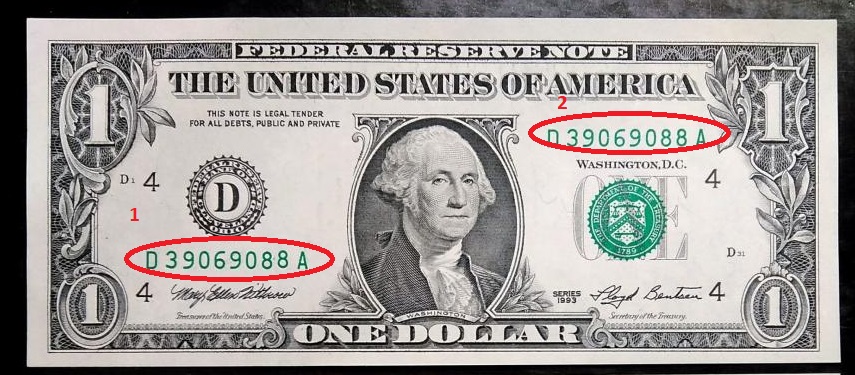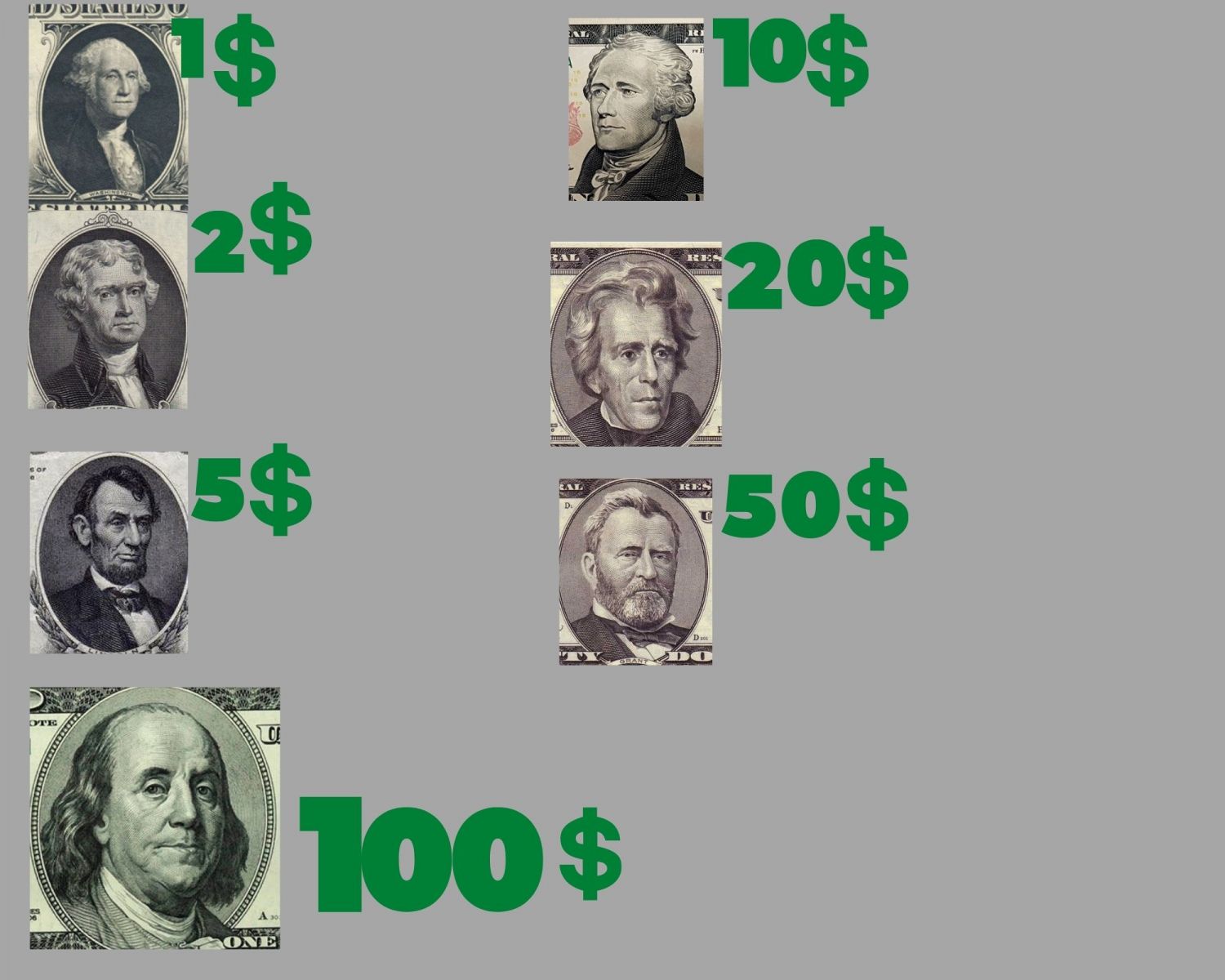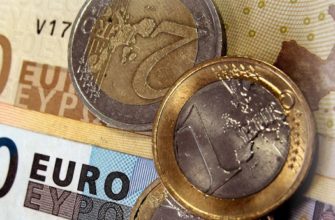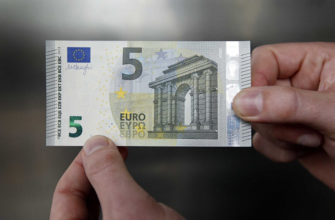Fluctuations in the exchange rate of the ruble force compatriots to widely use the US currency for savings and settlements between individuals. In order not to become a victim of scammers, you need to know how you can check the authenticity of the dollar without resorting to the help of specialists.
- What do dollars look like: a description of the appearance
- What is the largest US dollar bill currently?
- Banknotes that are most often counterfeited
- Checking 100 dollar bill
- Self-verification of currency authenticity by visual signs: what to look for
- Water marks
- Paper
- Dye
- President's portrait
- colored fibers
- Guard strip
- Relief printing
- Changing denomination color
- microprinting
- Serial number
- Tactile sensations
- Structure
- Thickness
- Security features
- Where are counterfeit dollars sold
- Where can I check the dollars for authenticity
- Actions if you sold a fake
What do dollars look like: a description of the appearance
Dollars are in circulation both within the United States and in many countries in Asia and Latin America. It is one of the most popular currencies in the world.
The appearance of banknotes varies depending on the denomination. On the front side, the central place is occupied by portraits of American presidents. On the back are images of historical monuments and attributes of US statehood.
| Banknote denomination | The statesman on the obverse | The depicted object on the reverse |
| 1 | D. Washington | The Great Seal of the United States, which is used to authenticate government acts |
| 2 | T. Jefferson | Reproduction of the painting "Declaration of Independence" by John Trumbull |
| 5 | A. Lincoln | Abraham Lincoln Memorial in Washington DC |
| 10 | A. Hamilton | US Treasury |
| 20 | E. Jackson | White House |
| 50 | W. Grant | Capitol |
| 100 | B. Franklin | Palace of Independence |
In free circulation, banknotes of 1.5, 10, 20 and 100 dollars are most often found. To quickly identify banknotes, it is advisable to remember the distinctive features of their design.
Read also: identify fake 5000 rubles in 15 sec
What is the largest US dollar bill currently?
Until 1945, banknotes were printed and put into circulation in denominations of 500, 1,000, 5,000 and 10,000 dollars. But three generations of Americans have grown up without ever seeing a single banknote in denominations above $100.
On July 14, 1969, an order was issued according to which none of the $500, $1,000, $5,000, and $10,000 denominations that entered the banks of the Federal Reserve System should go into circulation. However, these notes are still legal tender.

According to the US Secret Service, the Treasury Department issued a certificate with a face value of $100,000, or "gold certificate". It has never been in circulation and is used exclusively between US Federal Reserve banks.
Read also: how to check the authenticity of a coin
"Gold Certificate" of the US Department of the Treasury with a face value of $100,000

Attention! Ticket known as "million dollar" is not legal tender and has nothing to do with banknotes issued by the US Federal Reserve System.
The ticket is issued by the American Bank Note Company to members of the International Millionaires Association and is authenticated by a certificate.

Banknotes that are most often counterfeited
Creating a high quality fake is extremely expensive. For this reason, it is not advisable to falsify economic banknotes for small bills.
Counterfeit $20 bills are the most common in the United States. They are actively used in cash payments. Large purchases are more often paid by bank cards.

Outside the United States, scammers prefer to counterfeit $100 bills. Many people have little idea how exactly such bills look and how to distinguish them from fakes. Therefore, they are easier to distribute among tourists and local residents. At the same time, the production and sale of such banknotes brings high profits.
In 2010, a new $100 bill was presented, which has the latest security features. In practice, it is extremely difficult to fake it. Now the criminals practically do not touch it. Perhaps it's just a matter of time. However, old-style banknotes are still in use, and they are actively counterfeited.
The new $100 bill has a bluish tint, while the old one is green.
The image on them is also slightly modified, other fonts are used.
Checking 100 dollar bill
Since the new counterfeit dollars are an exceptional phenomenon, consider a more massive forgery, that is, old-style $100 banknotes:
How to distinguish dollars from fakes, signs of authenticity:
- material. The paper of a real dollar is actually cloth. It rustles a little, and if the money gets wet, after drying it will be normal, without defects;
- the print is three-dimensional, so a fake can be identified by touch - it is even;
- the inscription “$100” changes color at an angle (green, black);
- run your fingernail over Franklin's camisole, the real one's nail clings to the pattern;
- all numbers on the banknote must match (but it’s already clear that scammers observe this when counterfeiting the dollar). But sometimes they print the same numbers on the batch. If you receive several bills from someone at once, compare the numbers, they should not match;
- a protective strip is visible through the light, “USA 100” is written on it;
- the banknote frame is clear and uninterrupted, the ornaments are well expressed. Fakes may have blurring. The portrait of Franklin on real money is also clear and detailed.
If you come across a new banknote, then there is nothing to worry about. It is too complex for scammers.
Some scammers target tourists specifically. They wash away the denomination on the $1 or $5 bills and print "100" on it. Therefore, it is extremely important to know what exactly is depicted on 100 dollars - Franklin.
How to distinguish a fake 2 dollars? In fact, it is extremely rare, it can even be called a collector's item. And no one will fake it. But if it interests you for the purpose of collecting, then in general the verification method is the same as for $100 - visual.
How to distinguish a fake $ 50 - here, too, everything is the same, to the touch, visually. If you look at the light, you will see a protective line with the inscription "USA 50".

Self-verification of currency authenticity by visual signs: what to look for
There are several ways to identify counterfeit banknotes by external signs. In most cases, these methods allow you to identify fakes of low and medium quality without resorting to special equipment.
Read also: 1000 rubles
Water marks

Dollar bills printed after 1996 feature a portrait of the president on the right side of the bill. To see it, you need to examine the bill in the light. Watermarks have multiple shades of gray. A monochromatic image reveals a fake.
There are no security signs only on 1 and 2 dollar bills. The symbols on the security strip are readable on both sides and only in the light. Also in the light you can see a watermark that repeats the portrait on the bill.
Read also: what do the fake ones look like? 2000 rubles? Do not deceive us!
Paper
Dollars are made from paper made from a mixture of linen and cotton. When bending, you can hear a characteristic crunch. The paper of a real dollar is actually cloth.
It rustles a little, and if the money gets wet, after drying it will be normal, without defects.
Paper color is light yellow. When viewed through a magnifying glass, intertwined fibers are clearly visible.
Checking by touch, you need to pay attention to the quality of the paper. Regardless of whether it is a new banknote or an old one, the paper will be durable, emit a corresponding light “crunch” characteristic of it.
Read also: one hundred euro how to spot a fake
Dye
In the production of banknotes, a special ink is used, the composition of which is classified. It does not fade in the sun and does not fade over time. A black pigment with ferromagnetic properties is applied to the obverse. The image on the back of the banknote is printed with non-magnetized green ink. If you rub genuine banknotes against each other, the ink smearing does not occur.
Despite their small size, even the smallest drawings, the inscriptions are printed very clearly, without blurring. But on fakes they are often blurry. The ink on real banknotes contains small fibers. If you look through a magnifying glass, you can see them. The border should also be clear. On fakes, it is often blurry.
Read also: one hundred dollars how to spot a fake
Banknotes of 10 dollars and above have additional protection in the form of ink, which changes color depending on the angle of inclination.

President's portrait
A popular method of counterfeiting is to change the denomination of a genuine banknote. So you can get a 100-dollar bill from a 1-dollar one or a “twenty” from a 2-dollar one. At the same time, the portrait of the president remains unchanged. Therefore, it is recommended to remember the images that are placed on dollars of different denominations.
The portrait on the banknote should also be clear, with detail, while on fakes it is blurry.
Reproducing a portrait with high accuracy is not at all easy. Using artisanal methods, it is almost impossible to achieve a detailed drawing of small elements - pupils of the eyes, hairstyles, clothing textures. Therefore, when determining the authenticity of dollars, you should carefully study the quality of the portrait. The strokes on the background should be clear, without blurry spots and blurs.
colored fibers
On genuine banknotes, red and blue fibers are clearly visible, pressed into different depths of the paper. On fakes, this feature of dollars is imitated in different ways:
- printed along with other images on the printer;
- applied with colored felt-tip pens by hand;
- fibers extracted from real banknotes of a smaller denomination are pasted.
Such fakes are easy to identify with a magnifying glass. The number of security fibers in NextGen banknotes has been increased by 2-4 times compared to banknotes printed before 2006.
Guard strip
Since 1990 dollar bills have been secured with a security thread. It contains the denomination of the banknote, a stylized American flag and the inscription USA. The location of the strip on banknotes of different denominations varies. This is done to complicate the manufacture of fakes by applying an additional number.
Under UV rays, the band changes its color:
| Denomination | Color |
| $5 | Blue |
| $10 | Orange |
| $20 | Green |
| $50 | Yellow |
| $100 | Pink |

Read also: 50 dollar bill how to spot a fake
Relief printing
Relief printing is used to protect dollars. The print should be embossed to the touch. This is also a distinctive feature of genuine banknotes. For this, a secret technology is used, which, of course, is not disclosed to anyone. Therefore, each, even a small sign, if you touch a banknote with your hands, is palpable.
Many elements of images and inscriptions are used as marks for the blind, and as one of the degrees of protection. The easiest way to check the relief of a picture is to run your fingernail along the president's collar on a $100 bill. In this case, you can feel the vibration. If this effect is not observed, there is reason to suspect that the bill is a fake.
Changing denomination color
In the lower right corner of the banknote, the denomination changes its color when the banknote is tilted. Fakes don't have this feature. The change in colors varies on banknotes depending on the series.
On banknotes printed from 1996 to 2006, the digits successively take on green, cyan, blue and deep purple hues. On NextGen notes issued after 2006, the denomination changes color from dull copper to green.

Read also: 200 ruble bill how to spot a fake
microprinting
Since 1990, microtext has been used to protect dollars, which is placed on the security strip and the portrait. You can see it with a magnifying glass. On the 100 dollar bill, the repeating inscription "The United States of America" is applied along the edge of the oval.
Counterfeits often do not have this microprinting, as counterfeiters do not have the technical capability to apply it to their counterfeit banknotes.

Serial number
Each banknote has its own code. In denominations of 1 and 2 dollars, it consists of 8 numbers and 2 letters of the Latin alphabet. On bank notes of other denominations, the code consists of 8 digits and 3 letters. All symbols on dollars are printed using the same font with the same spacing. The serial number is repeated twice on the banknote. There can be no differences in letters and numbers on genuine bank notes. A mismatch of at least one character indicates a fake.
The series is printed twice, the serial number is the same color with a seal - the bill is real.
The series is determined by the first letter. 8 digits indicate the serial number of the banknote. It is easy to determine the date of manufacture of the banknote by the serial number. The checksum must correspond to the code of the unit that produced the bill. The ink color of the serial number matches that of the image of the US Treasury seal.
Tactile sensations
In many cases, it is possible to distinguish a fake from genuine bank notes by touch. To do this, it is useful to know which signs should be given priority attention.
Structure
In terms of physical properties, the material from which dollars are made is more reminiscent of cloth than cellulose paper.
Dollar bills have high mechanical strength. They tolerate the effects of water without consequences, and are easily restored after crushing. Bank notes are elastic and can stretch a little. On tactile examination, the material feels a bit rough.

Thickness
The thickness of the bill is less than fakes. When making real dollars in 2018 and earlier, the paper is pressed, so it is strong and thin. Counterfeiters have poor quality paper. If there is a similar denomination of the same denomination and the same series and there is confidence in its authenticity, you can compare them. They must be the same.
Visually, dollar bills look quite thick. However, this effect is achieved through the use of relief printing. The thickness of bank notes is actually quite small. Even the highest quality fakes are printed on thicker paper.
Security features
Genuine dollar bank notes have a number of degrees of protection:
- Magnetic - part of the image is made using paint with ferromagnetic properties. To check this characteristic, a special sensor is required, which is equipped with bill detectors.
- Iris rumble. Represents a gradient transition from one color to another. A home printer is not capable of simulating this effect.
- Banknote size. The dollars in circulation are 155.956 mm long and 66.294 mm wide. A deviation of no more than 2 mm in both directions is allowed.
- 3D ribbon used in 100 dollar bills. On it you can see the numbers and images of bells, which shift when the angle of inclination changes.
- Metallic paint. Used to print banknotes of the NextGen series. On the obverse of the $10, $20, and $50 tickets, to the right of the president's portrait, there are images of the Statue of Liberty's torch, an eagle with a shield, and a star, respectively.
- Background glow in ultraviolet. Genuine banknotes do not have this phenomenon. The paper used by the scammers will glow when exposed to UV rays. At the same time, security fibers that are embedded in the paper structure and a hidden thread passing through the entire width of the banknote luminesce in genuine banknotes.
Where are counterfeit dollars sold
Most often they fall into the hands of tourists who have not seen dollars in their eyes before or have seen them, but not so often. So, if you are traveling to a country where this currency is in use, be sure to check out how to distinguish fake dollars from real ones.
You can be given fake $50 for change at any time, and sometimes you can stumble upon fake $100 even in not entirely honest exchangers. It definitely won't hurt to be vigilant.
In Russia, the risk of getting a fake dollar is extremely small. If you buy currency at a bank, they will definitely not issue a fake. And if you make a transaction at a non-bank point (for example, send a money transfer in foreign currency), carefully check the change. If you receive a transfer in foreign currency, then study all the banknotes issued. The cashier himself can skip the fake and unknowingly give it to you.
If a counterfeit dollar fell into your hands, if you wondered too late how to recognize a counterfeit dollar, the situation is unpleasant. You just already lost your money. It will not be possible to sell a non-original bill, even if desired, in Russia stores do not work with it.
First, contact the place where you received the bill from. Of course, if possible: sometimes people bring fakes from other countries. If the counterfeit dollar is received domestically and the damage is significant, you can contact the police. Perhaps if the scammer is exposed, you can return something through the courts. But you have to tinker - this is a fact.

Where can I check the dollars for authenticity
You can verify the authenticity of dollars in banking organizations. The method is highly reliable, but will require some costs, because. such a service is paid.
There is another convenient option for checking banknotes - visiting a representative office of a banking equipment supplier.
Retailers have samples of bill detectors in their office for demonstration purposes. Before visiting the representative office, you will need to agree on a presentation. To check the operation of the machines, you can use your own banknote samples, which raise doubts about the authenticity. Presentation and consultations are free of charge. Participation in the demonstration does not impose any obligations on the purchase of devices for the participants of the event.

Actions if you sold a fake
Any use of counterfeit banknotes is subject to Article 186 of the Criminal Code of the Russian Federation. It provides for punishment from 5 to 15 years for the manufacture and sale of counterfeit money and securities. Therefore, it is important to understand what to do if a fake banknote falls into your hands. In this case, you need:
- Put the banknote in a clean bag. At the same time, you should touch it as little as possible in order to preserve the fingerprints of fraudsters.
- Try to fix the circumstances of obtaining a fake. It is important not to forget the date and time of the incident.
- Remember the signs of the person from whom the fake was received.
- Contact the police and hand over banknotes as material evidence.
Under no circumstances should counterfeit money be used for payment or transferred to other people. Such actions are qualified as unlawful and are punished in accordance with the provisions of the Criminal Code.









-335x220.jpg)







Quite a long-standing problem that a normal entrepreneur who is familiar with such a currency as the dollar periodically has to deal with. It was useful to get acquainted.
Very informative, before I did not notice these details, and now after reading the article I will be very careful when buying in cash!
great article and I will keep it in my bookmarks
A very extensive and complete overview of the US dollar. Yes, to be able to distinguish a fake from the original, this means saving yourself from many troubles and trials. Thanks for the article, be sure to bookmark.
Fraudsters are very fond of counterfeiting money and dollars are no exception here. Therefore, bills should always be very carefully and closely studied. Otherwise, you can run into a fake. And it will be very annoying!
Useful and important information, thanks!
The article is written correctly, but in some points I can not agree with the author. For example, an error in the number symbol or its partial non-printing is not a fake, but a technological defect in banknote printing. Also, US banknotes with missing seals are extremely rare in circulation. Such banknotes are correctional rarity and cost many tens of thousands of rubles. Naturally, subject to the coincidence of the remaining signs of the authenticity of the banknote.